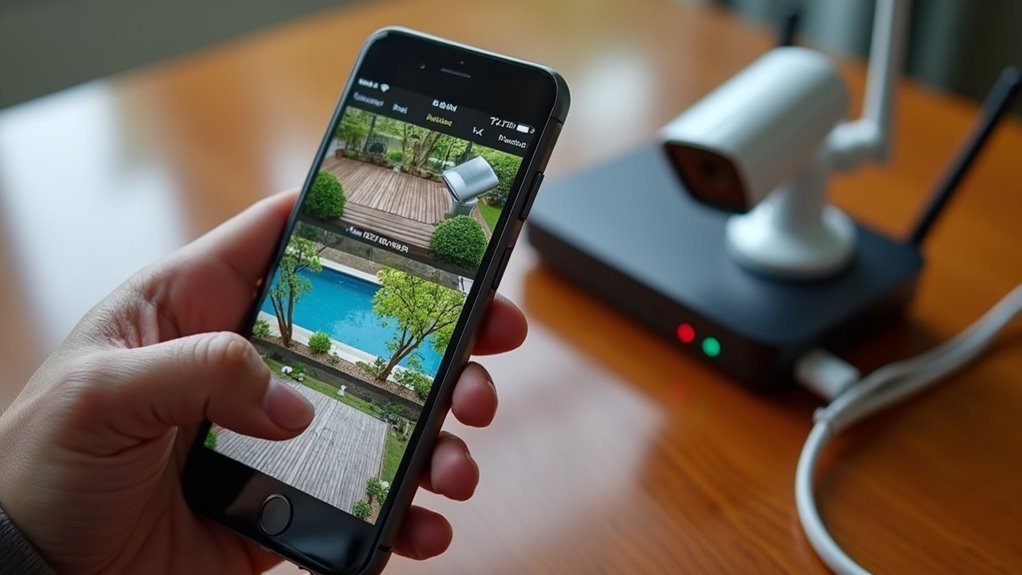You’ve spent countless hours perfecting your Home Assistant setup, automating everything from lights to security systems, but now you want to control it all while you’re away from home. The challenge isn’t just getting remote access—it’s doing it safely without exposing your entire smart home network to cybercriminals who’d love nothing more than to infiltrate your personal sanctuary. The wrong approach could turn your convenience into a security nightmare.
Understanding Home Assistant Remote Access Fundamentals

When you set up Home Assistant, remote access isn’t enabled by default—you’ll need to configure it yourself to control your smart home system from anywhere outside your local network.
Home Assistant requires manual configuration for remote access since it operates as a local-only system by default.
This feature transforms your local automation hub into a globally accessible control center, letting you adjust thermostats, check security cameras, and manage devices while traveling or at work.
However, enabling remote access requires careful consideration of security protocols. Your system must establish encrypted connections to prevent unauthorized access to your home’s smart devices.
Secure remote access typically involves SSL certificates, proper authentication methods, and secure networking configurations. Without these protections, you’re potentially exposing your entire home automation system to security vulnerabilities, making proper setup essential for safe operation.
Security Risks of Exposing Your Home Assistant Instance
While proper security protocols form the foundation of safe remote access, exposing your Home Assistant instance to the internet inherently creates attack vectors that malicious actors can exploit.
Determined attackers use port scanning and SSL certificate mining to discover vulnerable services, making obscuring domain names or changing ports ineffective since SSL certificates remain publicly accessible.
Port forwarding creates particularly dangerous security risks, as the security community actively discourages this method due to inherent vulnerabilities.
Even VPN solutions can provide false security through weaknesses in technology and inadequate user access management. Your exposed services become discoverable through platforms like Shodan, considerably increasing breach likelihood.
You’ll need regular monitoring and alerts for unauthorized access attempts to maintain any level of remote access security.
Home Assistant Cloud (Nabu Casa) Remote Access Solution

Home Assistant Cloud (Nabu Casa) eliminates the security vulnerabilities discussed earlier by providing a professionally managed remote access solution that doesn’t expose your local instance to the internet.
This service generates a unique URL specifically for your installation, enabling seamless connectivity from anywhere without technical configuration.
You’ll benefit from end-to-end encryption that secures all communication between your Home Assistant instance and remote devices.
The solution requires no port forwarding or complex network modifications, making it accessible regardless of your technical expertise.
Home Assistant Cloud integrates with Amazon Alexa and Google Assistant for voice control functionality.
At $5.50 monthly, you get unlimited usage while supporting Home Assistant’s development.
This approach provides enterprise-level security through professional infrastructure management.
Setting up VPN Access With Tailscale and Zerotier
For users seeking more control over their remote access infrastructure, VPN solutions like Tailscale and ZeroTier offer compelling alternatives to cloud-based services.
These peer-to-peer platforms create secure tunnels for remote access to Home Assistant without exposing your instance directly to the internet.
Setting up Tailscale is straightforward—you’ll install the app on your devices and authenticate to establish an automatic VPN connection.
ZeroTier requires creating a virtual network and adding your devices to it. Both services provide end-to-end encryption, ensuring your data remains protected from unauthorized access.
You’ll benefit from faster connections through peer-to-peer networking and enjoy free tiers suitable for personal use.
These solutions eliminate complex router configurations while maintaining robust security for your smart home infrastructure.
Port Forwarding Configuration and Dynamic DNS Setup

You’ll need to configure your router’s port forwarding settings to direct external traffic to your Home Assistant instance on port 8123.
Setting up a dynamic DNS service like DuckDNS guarantees you can reliably access your system even when your ISP changes your public IP address.
However, you must carefully assess the security risks since port forwarding exposes your Home Assistant directly to internet traffic.
Router Port Configuration
Two primary components form the backbone of router port configuration: port forwarding setup and dynamic DNS implementation.
You’ll need to configure your router to direct incoming traffic on port 8123 to your Home Assistant host’s local IP address. Access your router’s web interface and locate the “Port Forwarding” or “Virtual Server” section—consult your router’s manual if needed.
Dynamic DNS services like DuckDNS solve the challenge of changing IP addresses by providing a consistent hostname that points to your current network IP.
Before enabling port forwarding, update your router’s firmware to patch security vulnerabilities. Remember that port forwarding exposes your Home Assistant instance to the internet, so implement strong passwords and SSL certificates to maintain security.
Dynamic DNS Services
Setting up dynamic DNS services becomes essential when your internet service provider assigns you a dynamic IP address that changes periodically.
Without a stable address, you’ll lose remote access to your Home Assistant whenever your IP changes. Dynamic DNS services like DuckDNS solve this problem by providing a consistent domain name that automatically updates with your current IP address.
To configure dynamic DNS services effectively:
- Register with a provider – Sign up for DuckDNS or another dynamic DNS service and create your unique domain name
- Configure automatic updates – Set up Home Assistant to automatically update your DNS record whenever your IP address changes
- Monitor regularly – Check your dynamic DNS settings periodically to guarantee reliable remote access functionality
Security Risk Assessment
While port forwarding and dynamic DNS services enable convenient remote access to your Home Assistant, they introduce significant security risks that require careful assessment and mitigation. You’re fundamentally exposing your system to the internet, creating potential entry points for attackers who use port scanning techniques to identify vulnerabilities.
| Risk Factor | Mitigation Strategy |
|---|---|
| Exposed ports vulnerable to attacks | Implement strong passwords and two-factor authentication |
| Unencrypted data transmission | Enable TLS/SSL with end-to-end encryption via Let’s Encrypt |
| Unauthorized access attempts | Monitor access logs and configure failed login notifications |
These security vulnerabilities become more pronounced with misconfigured setups. You’ll need to regularly assess your configuration, ensuring end-to-end encryption protects your data traffic and monitoring systems alert you to suspicious activities.
Implementing Ssl/Tls Certificates With Let’s Encrypt
Now you’ll secure your Home Assistant instance by implementing SSL/TLS certificates through Let’s Encrypt, which provides free certificates that encrypt all communication between your server and clients.
You’ll start by generating certificates using the domain validation process, then integrate with DuckDNS to streamline the authentication workflow.
Finally, you’ll configure automatic renewal to guarantee your certificates stay valid without manual intervention every 90 days.
Certificate Generation Process
Before you can secure your Home Assistant installation with HTTPS, you’ll need to generate SSL/TLS certificates through Let’s Encrypt’s automated process.
The certificate generation process involves several key steps that establish trust and verify your domain ownership.
Here’s how the Let’s Encrypt certificate generation works:
- Create a Certificate Signing Request (CSR) – You’ll generate a request containing your domain information and public key details for the certificate authority.
- Complete domain validation – Let’s Encrypt verifies you control the domain through either HTTP-01 challenges (placing files on your web server) or DNS-01 challenges (adding DNS records).
- Receive your certificate – Once validation succeeds, Let’s Encrypt issues your certificate, which you’ll install on your Home Assistant server to enable encrypted HTTPS connections.
DuckDNS Integration Setup
How can you secure your Home Assistant installation when you don’t have a static IP address or registered domain name?
DuckDNS provides the perfect solution by offering free dynamic DNS services that automatically track your changing IP address.
Start by creating a DuckDNS account and setting up your custom subdomain.
Install the DuckDNS add-on in Home Assistant, which will automatically update your DNS records whenever your external IP changes. This guarantees consistent remote access without manual updates.
The real advantage comes when integrating Let’s Encrypt certificates through DuckDNS.
This combination provides SSL/TLS encryption for secure communication.
After setup, configure your Home Assistant external URL settings to use your new domain name, enabling encrypted access through your personalized DuckDNS subdomain.
Automatic Renewal Configuration
SSL/TLS certificates from Let’s Encrypt expire every 90 days, making automatic renewal critical for maintaining uninterrupted secure access to your Home Assistant instance.
Without proper automation, you’ll face certificate expiration warnings and potential connection failures that’ll disrupt your smart home management.
Setting up automatic renewal with Certbot guarantees your certificates stay current:
- Configure a cron job or systemd timer to run renewal checks every 60 days, well before the 90-day expiration period.
- Verify your domain consistently points to your server since Let’s Encrypt requires domain validation for successful renewal.
- Monitor renewal logs regularly to catch any DNS or connectivity issues that might prevent automatic certificate updates.
Once configured, Certbot handles the entire renewal process, deploying fresh certificates without downtime or manual intervention.
Configuring Reverse Proxy With Nginx for Secure Access
When you’re looking to add robust security to your Home Assistant setup, configuring Nginx as a reverse proxy creates a protective barrier between your smart home system and the internet.
Nginx reverse proxy shields your Home Assistant from direct internet exposure while maintaining secure remote access capabilities.
This configuration obscures your Home Assistant’s IP address while providing enhanced remote access security.
Start by installing Nginx on your server and configuring it to listen on port 443 for HTTPS traffic, then forward requests to Home Assistant’s port 8123.
You’ll need a valid SSL certificate from Let’s Encrypt for encrypted communication.
Your Nginx configuration should enforce HTTPS, include security headers like X-Frame-Options and X-XSS-Protection, and enable rate limiting against brute force attacks.
Regular updates to both Nginx and Home Assistant are essential, along with monitoring logs for unauthorized access attempts.
Two-Factor Authentication and Login Security Measures
Building upon the secure foundation of your reverse proxy configuration, implementing two-factor authentication (2FA) transforms your Home Assistant login from a single point of failure into a multi-layered defense system.
Even if attackers compromise your password, they’ll still need that second verification factor to gain access.
Essential login security measures include:
- Enable authenticator apps – Use Google Authenticator or Authy for time-based codes that don’t rely on SMS vulnerabilities.
- Configure failed login notifications – Set up alerts that notify you immediately when unauthorized access attempts occur.
- Maintain regular updates – Keep Home Assistant current since security patches often address critical vulnerabilities.
Your two-factor authentication setup greatly reduces unauthorized access risks while providing flexibility in choosing your preferred verification method, whether through mobile apps or SMS codes.
Homeway Community Project for Free Remote Access
While setting up your own reverse proxy and SSL certificates provides excellent security, the Homeway Community Project offers a simplified alternative that eliminates the technical complexity entirely.
This community-driven service provides free and secure remote access to your Home Assistant installation without exposing it to the public internet.
You’ll access your smart home through Homeway’s secure portal by logging into your account, keeping your sensitive data private and protected.
The service offers limited free usage, with unlimited access available for just $2.49 monthly—significantly cheaper than commercial alternatives.
Homeway requires no technical setup or complex configuration, making remote access accessible regardless of your skill level.
Your Home Assistant instance remains completely private, reducing unauthorized access risks while maintaining full control over your smart home devices from anywhere.
Cloudflare Tunnels for Zero-Trust Network Access
You’ll find Cloudflare Tunnels offer a robust Zero Trust solution that eliminates the need for port forwarding while securing your Home Assistant setup.
The tunnel setup process involves creating a Cloudflare account, configuring the tunnel through their CLI tool, and establishing DNS records for seamless external access.
This approach provides end-to-end encryption through Cloudflare’s global network, protecting your smart home from DDoS attacks and unauthorized access attempts.
Cloudflare Tunnel Setup
One of the most secure methods for exposing your Home Assistant instance to the internet involves using Cloudflare Tunnel, which eliminates the need for traditional port forwarding while keeping your local IP address completely hidden.
Setting up Cloudflare Tunnel for remote access requires three essential steps:
- Create your Cloudflare account and configure a new tunnel through the Zero Trust dashboard, where you’ll generate authentication credentials for your connection.
- Install the cloudflared daemon on your Home Assistant server and authenticate it using the tunnel token provided by Cloudflare’s interface.
- Configure the tunnel routing by specifying your Home Assistant’s local address (typically localhost:8123) to establish the secure connection between Cloudflare’s edge network and your instance.
This process creates an encrypted pathway that protects your data while enabling authorized remote access.
Zero-Trust Security Benefits
Beyond the technical setup, Cloudflare Tunnel’s greatest strength lies in its implementation of zero-trust security principles that fundamentally change how you control access to your Home Assistant instance.
You’ll eliminate direct internet exposure, dramatically reducing your attack surface while maintaining seamless remote access. Every request undergoes verification regardless of location, implementing the “never trust, always verify” approach.
You’ll benefit from continuous authentication for all users and devices, enabling granular access controls tailored to specific needs.
Cloudflare’s integrated Web Application Firewall provides additional protection against DDoS attacks and SQL injection attempts.
Most importantly, you’ll maintain end-to-end encryption throughout your remote access sessions, ensuring sensitive smart home data remains secure in transit while enjoying the convenience of accessing your system from anywhere.
Network Configuration and Router Security Settings
Network configuration forms the backbone of secure remote access to your Home Assistant instance, requiring careful attention to both connectivity and security measures.
Your router security settings play an essential role in maintaining a protected connection while enabling external access.
Router security settings form the critical foundation for balancing protected connections with reliable external access capabilities.
- Configure port forwarding to direct traffic to port 8123 of your Home Assistant host, enabling external connectivity while implementing Dynamic DNS services like DuckDNS to handle dynamic IP addresses from your ISP.
- Implement VPN solutions such as Tailscale or ZeroTier One on your router to establish encrypted connections before accessing Home Assistant remotely, ensuring secure tunneling.
- Maintain router security by regularly updating firmware, changing default passwords, disabling remote management, and correctly configuring external URLs in Home Assistant’s network settings through Advanced mode.
Monitoring and Alerting for Unauthorized Access Attempts
While establishing secure network configurations provides your first line of defense, you’ll need robust monitoring and alerting systems to detect when unauthorized users attempt to breach your Home Assistant instance.
Implementing Fail2Ban helps scan log files for suspicious activity and automatically blocks repeated unauthorized access attempts. You should configure alerts for failed login attempts to receive immediate notifications when potential security breaches occur.
Home Assistant’s built-in logging capabilities enable you to track all access attempts, helping identify patterns or sources of unauthorized access.
Configure two-factor authentication (2FA) to add an additional verification layer that greatly diminishes unauthorized access risks.
Regularly review your access logs and alert settings to guarantee timely adjustments based on observed patterns and emerging threats.
Best Practices for Maintaining Secure Remote Connections
Once you’ve established monitoring systems to detect threats, maintaining secure remote connections requires consistent implementation of proven security practices.
Protecting your Home Assistant instance demands a multi-layered approach that evolves with emerging security threats. Here are essential practices to maintain robust security:
- Deploy a secure VPN solution like Tailscale or ZeroTier One to encrypt all remote connections. These solutions eliminate the need for port forwarding while ensuring only authorized devices can access your system.
- Enable two-factor authentication (2FA) for all Home Assistant access points. This additional security layer greatly reduces unauthorized login risks, even if passwords are compromised.
- Maintain regular updates for Home Assistant and all components. Set up automated update notifications and apply security patches promptly to address newly discovered vulnerabilities.
Frequently Asked Questions
How Do I Secure Remote Access to Home Assistant?
You’ll secure remote access by using Home Assistant Cloud or setting up a VPN like Tailscale. Enable two-factor authentication, avoid port forwarding, and regularly update your instance to maintain security.
What Is Secure Remote Access?
You’re accessing systems outside your local network through encrypted connections that protect your data from interception. It prevents unauthorized users from gaining entry while maintaining privacy and authentication standards.
What Are the Security Options for Home Assistant?
You can secure Home Assistant using Nabu Casa’s encrypted service, Tailscale VPN for peer-to-peer connections, mTLS for client authentication, two-factor authentication, and regular updates with access monitoring.
What Is Insecure Remote Access?
You’re using insecure remote access when you expose your system directly to the internet through simple port forwarding, rely on weak passwords, skip two-factor authentication, or use unencrypted connections that attackers can exploit.





Leave a Reply